Popular information
Information for the public:
Particle control in a quantum world (pdf)
Populärvetenskaplig information:
Partikeldressyr i kvantvärlden (pdf)

The Nobel Prize in Physics 2012
Serge Haroche and David J. Wineland have independently invented and developed ground-breaking methods for measuring and manipulating individual particles while preserving their quantum-mechanical nature, in ways that were previously thought unattainable.
Particle control in a quantum world
Haroche and Wineland have opened the door to a new era of experimentation with quantum physics by demonstrating the direct observation of individual quantum systems without destroying them. Through their ingenious laboratory methods they have managed to measure and control very fragile quantum states, enabling their field of research to take the very first steps towards building a new type of super fast computer, based on quantum physics. These methods have also led to the construction of extremely precise clocks that could become the future basis for a new standard of time, with more than hundred-fold greater precision than present-day caesium clocks.
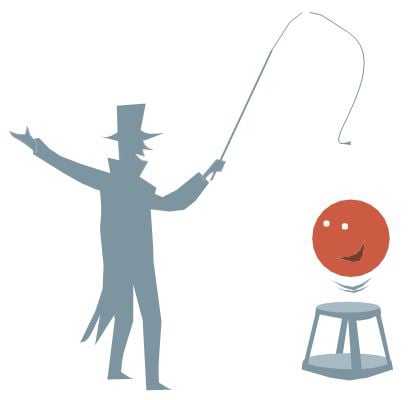
For single particles of light or matter, the laws of classical physics cease to apply and quantum physics takes over. But single particles are not easily isolated from their surrounding environment and they lose their mysterious quantum properties as soon as they interact with the outside world. Thus many seemingly bizarre phenomena predicted by quantum mechanics could not be directly observed, and researchers could only carry out ‘thought experiments’ that might in principle manifest these bizarre phenomena.
Both Laureates work in the field of quantum optics studying the fundamental interaction between light and matter, a field which has seen considerable progress since the mid-1980s. Their methods have many things in common. David Wineland traps electrically charged atoms, or ions, controlling and measuring them with light, or photons. Serge Haroche takes the opposite approach: he controls and measures trapped photons, or particles of light, by sending atoms through a trap.
Controlling single ions in a trap
In David Wineland’s laboratory in Boulder, Colorado, electrically charged atoms or ions are kept inside a trap by surrounding them with electric fields. The particles are isolated from the heat and radiation in their environment by performing the experiments in vacuum at extremely low temperatures.
One of the secrets behind Wineland’s breakthrough is the mastery of the art of using laser beams and creating laser pulses. A laser is used to suppress the ion’s thermal motion in the trap, putting the ion in its lowest energy state and thus enabling the study of quantum phenomena with the trapped ion. A carefully tuned laser pulse can be used to put the ion in a superposition state, which is a simultaneous existence of two distinctly different states. For example, the ion can be prepared to occupy two different energy levels simultaneously. It starts in a lowest energy level and the laser pulse only nudges the ion halfway towards a higher energy level so that it is left in between the two levels, in a superposition of energy states, with an equal probability of ending up in either of them. In this way a quantum superposition of the ion’s energy states can be studied.
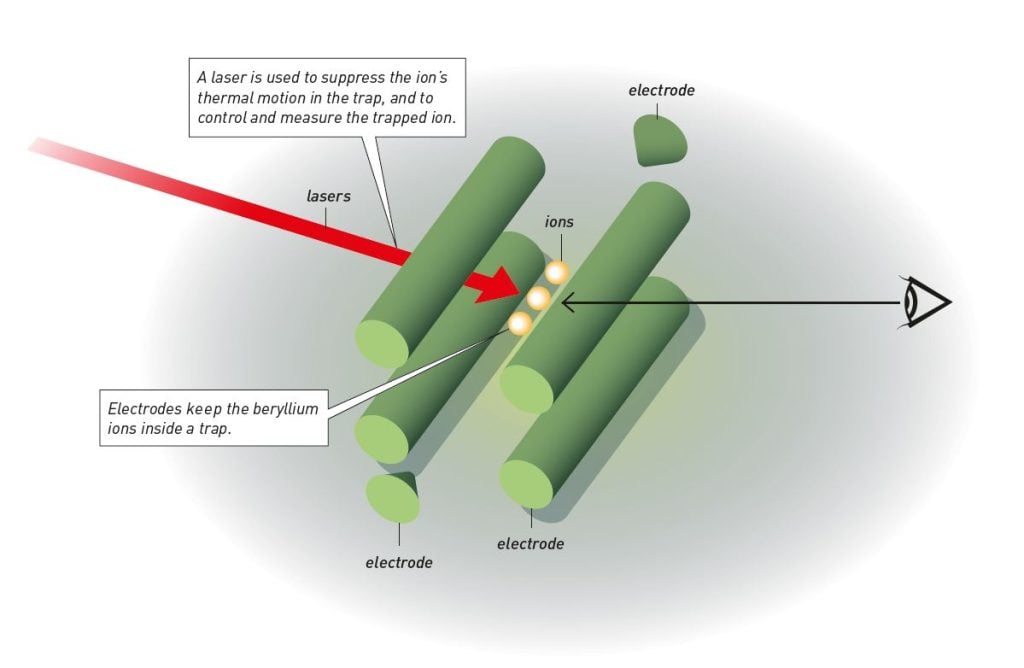
Controlling single photons in a trap
Serge Haroche and his research group employ a different method to reveal the mysteries of the quantum world. In the laboratory in Paris microwave photons bounce back and forth inside a small cavity between two mirrors, about three centimetres apart. The mirrors are made of superconducting material and are cooled to a temperature just above absolute zero. These superconducting mirrors are the world’s shiniest. They are so reflective that a single photon can bounce back and forth inside the cavity for almost a tenth of a second before it is lost or absorbed. This record-long life-time means that the photon will have travelled 40,000 kilometres, equivalent to about one trip around the Earth.
During its long life time, many quantum manipulations can be performed with the trapped photon. Haroche uses specially prepared atoms, so-called Rydberg atoms (after the Swedish physicist Johannes Rydberg) to both control and measure the microwave photon in the cavity. A Rydberg atom has a radius of about 125 nanometers which is roughly 1,000 times larger than typical atoms. These gigantic doughnut-shaped Rydberg atoms are sent into the cavity one by one at a carefully chosen speed, so that the interaction with the microwave photon occurs in a well controlled manner.
The Rydberg atom traverses and exits the cavity, leaving the microwave photon behind. But the interaction between the photon and the atom creates a change in the phase of quantum state of the atom: if you think of the atom’s quantum state as a wave, the peaks and the dips of the wave become shifted. This phase shift can be measured when the atom exits the cavity, thereby revealing the presence or absence of a photon inside the cavity. With no photon there is no phase shift. Haroche can thus measure a single photon without destroying it.
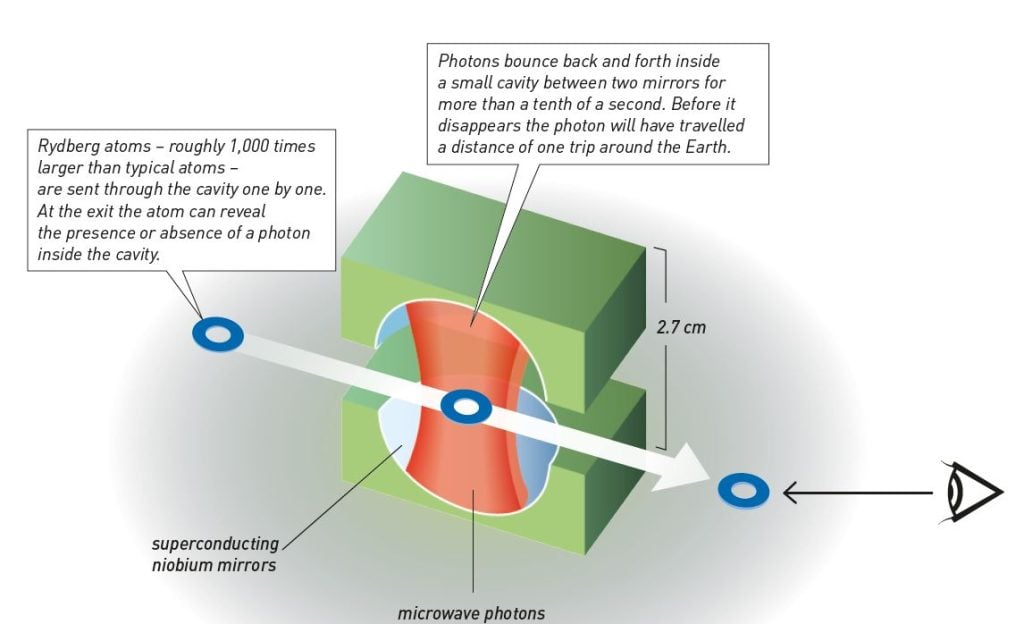
With a similar method Haroche and his group could count the photons inside the cavity, as a child counts marbles in a bowl. This may sound easy but requires extraordinary dexterity and skill because photons, unlike ordinary marbles, are destroyed immediately by contact with the world outside. Building on his photon counting methods, Haroche and collaborators devised methods to follow the evolution of an individual quantum state, step-by-step, in real time.
Paradoxes of quantum mechanics
Quantum mechanics describes a microscopic world invisible to the naked eye, where events occur contrary to our expectations and experiences with physical phenomena in the macroscopic, classical world. Physics in the quantum world has some inherent uncertainty or randomness to it. One example of this contrary behaviour is superposition, where a quantum particle can be in several different states simultaneously. We do not normally think of a marble as being both ‘here’ and ‘there’ at the same time, but such is the case if it were a quantum marble. The superposition state of this marble tells us exactly what probability the marble has of being here or there, if we were to measure exactly where it is.
Why do we never become aware of these strange facets of our world? Why can we not observe a superposition of quantum marble in our every-day life? The Austrian physicist and Nobel Laureate (Physics 1933) Erwin Schrödinger battled with this question. Like many other pioneers of quantum theory, he struggled to understand and interpret its implications. As late as 1952, he wrote: “We never experiment with just one electron or atom or (small) molecule. In thought-experiments we sometimes assume that we do; this invariably entails ridiculous consequences…”.
In order to illustrate the absurd consequences of moving between the micro-world of quantum physics and our every-day macro-world, Schrödinger described a thought experiment with a cat: Schrödinger’s cat is completely isolated from the outside world inside a box. The box also contains a bottle of deadly cyanide which is released only after the decay of some radioactive atom, also inside the box.
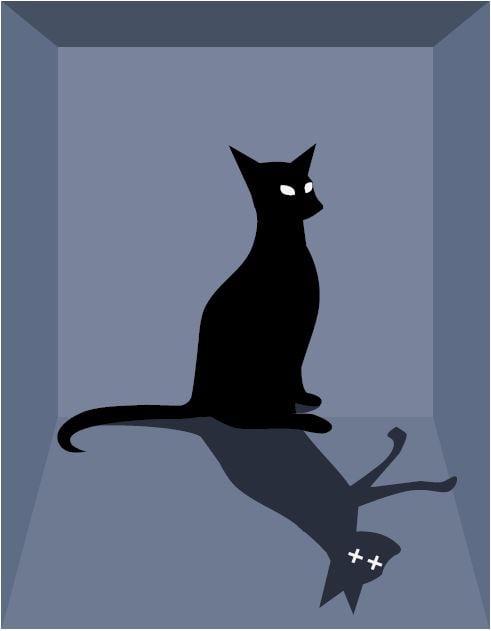
The radioactive decay is governed by the laws of quantum mechanics, according to which the radioactive material is in a superposition state of both having decayed and not yet decayed. Therefore the cat must also be in a superposition state of being both dead and alive. Now, if you peek inside the box, you risk killing the cat because the quantum superposition is so sensitive to interaction with the environment that the slightest attempt to observe the cat would immediately ‘collapse’ the ‘cat-state’ to one of the two possible outcomes – dead or alive. In Schrödinger’s view this thought experiment lead to an absurd conclusion, and it is said that he later tried to apologize for adding to the quantum confusion.
Both Nobel Laureates of 2012 have been able to map the quantum cat-state when it encounters outside world. They have devised creative experiments and managed to show in great detail how the act of measuring actually causes the quantum state to collapse and loose its superposition character. Instead of Schrödinger’s cat, Haroche and Wineland trap quantum particles and put them in cat-like superposition states. These quantum objects are not really macroscopic as a cat, but they are still quite large by quantum standards.
Inside Haroche’s cavity microwave photons are put in cat-like states with opposite phases at the same time, like a stopwatch with a needle that spins both clockwise and counterclockwise simultaneously. The microwave field inside the cavity is then probed with Rydberg atoms. The result is another unintelligible quantum effect called entanglement. Entanglement has also been described by Erwin Schrödinger and can occur between two or more quantum particles that have no direct contact but still can read and affect the properties of each other. Entanglement of the microwave field and Rydberg atoms allowed Haroche to map the life and death of the cat-like state inside his cavity, following it step by step, atom by atom, as it underwent a transition from the quantum superposition of states to a well defined state of classical physics.
On the verge of a new computer revolution
A possible application of ion traps that many scientists dream of is the quantum computer. In present-day classical computers the smallest unit of information is a bit that takes the value of either 1 or 0. In a quantum computer, however, the basic unit of information – a quantum bit or qubit – can be 1 and 0 at the same time. Two quantum bits can simultaneously take on four values – 00, 01, 10 and 11 – and each additional qubit doubles the amount of possible states. For n quantum bits there are 2n possible states, and a quantum computer of only 300 qubits could hold 2300 values simultaneously, more than the number of atoms in the universe.
Wineland’s group was the first in the world to demonstrate a quantum operation with two quantum bits. Since control operations have already been achieved with a few qubits, there is in principle no reason to believe that it should not be possible to achieve such operations with many more qubits. However, to build such a quantum computer is an enormous practical challenge. One has to satisfy two opposing requirements: the qubits need to be adequately isolated from their environment in order not to destroy their quantum properties, yet they must also be able to communicate with the outside world in order to pass on the results of their calculations. Perhaps the quantum computer will be built in this century. If so, it will change our lives in the same radical way as the classical computer transformed life in the last century.
New clocks
David Wineland and his team of researchers have also used ions in a trap to build a clock that is a hundred times more precise than the caesium-based atomic clocks which are currently the standard for our measurement of time. Time is kept by setting, or synchronizing all clocks against one standard. Caesium clocks operate in the microwave range whereas Wineland’s ion clocks use visible light – hence their name: optical clocks. An optical clock can consist of just one ion or two ions in a trap. With two ions, one is used as the clock and the other is used to read the clock without destroying its state, or causing it to miss a tick. The precision of an optical clock is better than one part in 1017, which means that if one had started to measure time at the beginning of the universe in the Big Bang about 14 billion years ago, the optical clock would only have been off by about five seconds today.
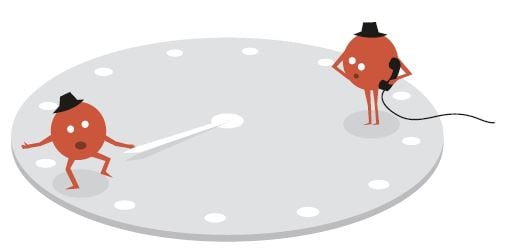
With such precise measurement of time, some extremely subtle and beautiful phenomena of nature have been observed, such as changes in the flow of time, or minute variations of gravity, the fabric of space-time. According to Einstein’s theory of relativity, time is affected by motion and gravity. The higher the speed and the stronger the gravity, the slower the passage of time. We may not be aware of these effects, but they have in fact become part of our everyday life. When we navigate with the GPS we rely on time signals from satellites with clocks that are routinely calibrated, because gravity is somewhat weaker several hundred kilometres up in the sky. With an optical clock it is possible to measure a difference in the passage of time when the clocks speed is changed by less than 10 metres per second, or when gravity is altered as a consequence of a difference in height of only 30 centimetres.
Links and further reading
Popular science articles
Monroe, C. R. and Wineland, D. J. (2008) Quantum Computing with Ions, Scientific American, August.
Yam, P. (1997) Bringing Schrödinger’s Cat to Life, Scientific American, June.
The Laureates
SERGE HAROCHE
French citizen. Born 1944 in Casablanca, Morocco. Ph.D. 1971 from Université Pierre et Marie Curie, Paris, France. Professor at Collège de France and Ecole Normale Supérieure, Paris, France.
www.college-de-france.fr/site/ en-serge-haroche/biography.htm
DAVID J. WINELAND
U.S. citizen. Born 1944 in Milwaukee, WI, USA. Ph.D. 1970 from Harvard University, Cambridge, MA, USA. Group Leader and NIST Fellow at National Institute of Standards and Technology (NIST) and University of Colorado Boulder, CO, USA.
www.nist.gov/pml/div688/grp10/index.cfm
Science Editors: Lars Bergström, Björn Jonson, Per Delsning and Anne l’Huillier, the Nobel Committee for Physics
Illustrations: © Johan Jarnestad/The Royal Swedish Academy of Sciences
Editor: Annika Moberg
© The Royal Swedish Academy of Sciences
Nobel Prizes and laureates
Six prizes were awarded for achievements that have conferred the greatest benefit to humankind. The 12 laureates' work and discoveries range from proteins' structures and machine learning to fighting for a world free of nuclear weapons.
See them all presented here.
